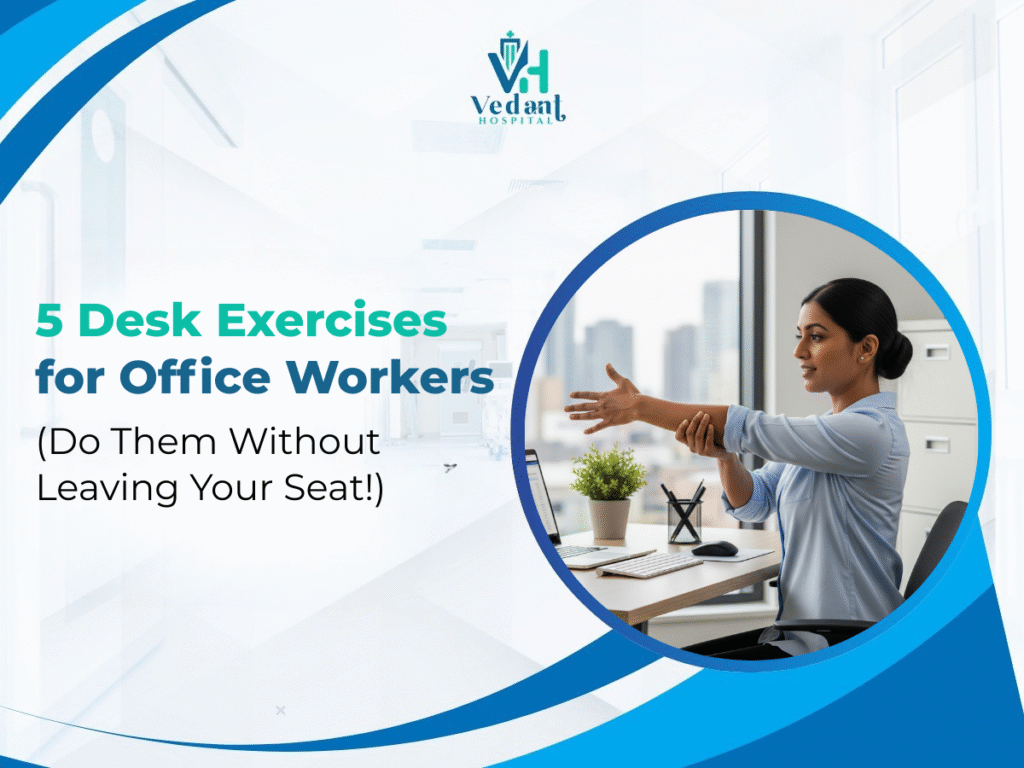If you’re an office worker, you probably spend long hours sitting at your desk. While this routine may feel normal, it can quietly lead to serious health problems like neck stiffness, back pain, and poor posture. Many people even end up needing medical treatments or traditional surgery because of years of unhealthy sitting habits.
That’s where desk exercises for office workers come in. With just a few simple stretches and movements, you can ease tension, improve blood circulation, and boost your energy—all without leaving your seat.
In this post, we’ll share 5 easy desk exercises for office workers that you can do in under 10 minutes. These moves are quick, effective, and designed to keep you healthier in the long run.
By the end, you’ll learn:
- Why desk exercises are essential for office health
- 5 proven exercises you can try right now
- How these simple moves can help you avoid future health complications (and even traditional surgery)
Why Desk Exercises for Office Workers Are Important
Modern office jobs require sitting for 8–10 hours daily. This leads to:
- Poor posture (slouching, rounded shoulders)
- Back and neck pain
- Increased risk of obesity, diabetes, and even heart issues
- Reduced productivity and focus
According to the World Health Organization, physical inactivity is one of the leading risk factors for global mortality. Just small, consistent movements throughout the day can reduce these risks.
That’s why practicing desk exercises for office workers is one of the simplest health hacks you can adopt.
5 Desk Exercises for Office Workers
1. Seated Spinal Twist (Relieve Back Pain)
Long sitting compresses your spine, leading to back pain and stiffness. A seated spinal twist helps stretch your back and improve spinal mobility.
How to do it:
- Sit tall in your chair with feet flat.
- Place your right hand on the backrest.
- Gently twist your torso to the right. Hold 10–15 seconds.
- Repeat on the left side.
This move prevents lower back issues that often lead to long-term damage and in severe cases, require traditional surgery for spinal correction.
2. Neck Rolls (Ease Neck & Shoulder Stiffness)
Neck stiffness is one of the most common office complaints. This exercise improves flexibility and relaxes muscles strained by computer work.
How to do it:
- Sit up straight and relax your shoulders.
- Slowly roll your head clockwise in a circle.
- Repeat anti-clockwise.
- Perform for 1–2 minutes.
3. Seated Leg Raises (Boost Circulation)
When sitting for hours, your legs may feel heavy or numb. Seated leg raises help improve circulation and prevent varicose veins.
How to do it:
- Sit upright, feet flat.
- Extend one leg straight and hold for 10 seconds.
- Lower it and switch sides.
- Repeat 10 times per leg.
This is especially important for workers with a family history of circulatory issues or who want to avoid hospital visits for leg-related problems.
4. Wrist & Finger Stretches (Prevent Carpal Tunnel)
Typing all day strains your wrists and fingers. Stretching helps prevent conditions like carpal tunnel syndrome.
How to do it:
- Extend one arm forward, palm up.
- Use the other hand to gently pull fingers back.
- Hold 10 seconds. Switch hands.
- Rotate wrists gently in circles.
5. Seated March (Full-Body Energy Boost)
This exercise mimics walking while seated. It gets your blood flowing and gives a quick energy boost.
How to do it:
- Sit upright.
- Lift one knee towards your chest, then lower.
- Repeat with the other leg in a marching motion.
- Do for 1–2 minutes.
Great for fighting afternoon fatigue without leaving your desk.
Pro Tips to Stay Healthy at the Office
- Take a 5-minute break every hour.
- Adjust your chair and monitor height to support posture.
- Stay hydrated (keep a water bottle at your desk).
- Use ergonomic furniture if possible.
When to Seek Medical Help
Desk exercises are preventive, but if you already suffer from chronic pain (neck, spine, or knees), it’s important to consult a doctor and visit a hospital. Ignoring symptoms can make things worse and sometimes lead to the need for traditional surgery.
FAQ – Desk Exercises for Office Workers
Q1: How often should I do desk exercises?
A: Aim for 5–10 minutes of movement every 1–2 hours of sitting.
Q2: Can desk exercises really replace workouts?
A: No, but they reduce the harmful effects of sitting. You should still include walking or workouts outside work.
Q3: What if I already have back pain?
A: Start with gentle stretches. If pain persists, consult a specialist at your nearest hospital.
Q4: Do these exercises really prevent surgery?
A: They reduce the risks, but chronic conditions may still need medical or surgical treatments. Prevention is always better.
Conclusion
Sitting for long hours may be part of modern office life, but it doesn’t have to harm your health. With these 5 easy desk exercises for office workers, you can protect your posture, ease pain, and stay more productive—all without leaving your seat.
But remember, small efforts today can prevent bigger health problems tomorrow. If you already struggle with pain or discomfort, don’t delay seeking medical advice. Sometimes, early treatment is the key to avoiding traditional surgery later on.
Ready to take the first step toward better health? Start with these desk exercises today, and if you need professional help, visit the nearest Hospital in Gwalior for expert guidance.


